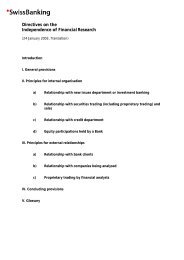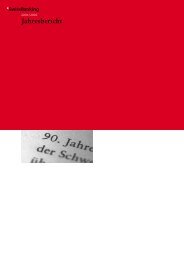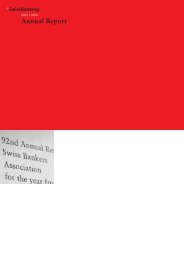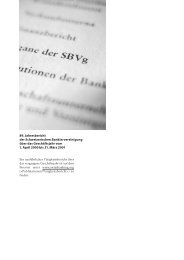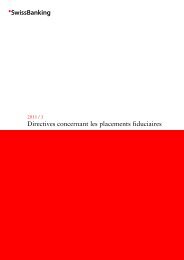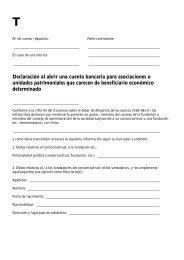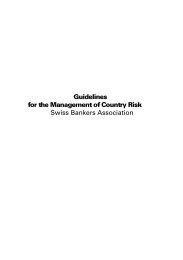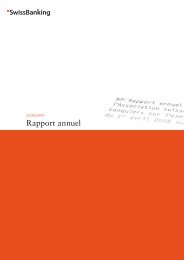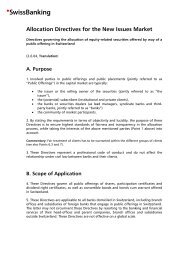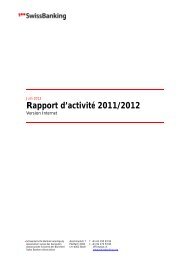Guidelines of the Swiss Bankers Association - SwissBanking
Guidelines of the Swiss Bankers Association - SwissBanking
Guidelines of the Swiss Bankers Association - SwissBanking
- No tags were found...
Create successful ePaper yourself
Turn your PDF publications into a flip-book with our unique Google optimized e-Paper software.
<strong>Guidelines</strong> <strong>of</strong><strong>the</strong> <strong>Swiss</strong> <strong>Bankers</strong><strong>Association</strong>on <strong>the</strong> treatment <strong>of</strong> dormant accounts,custody accounts and safe-deposit boxesheld in <strong>Swiss</strong> banks(replaces <strong>the</strong> guidelines dated8 th September 1995)
PreliminaryThe purpose <strong>of</strong> <strong>the</strong>se guidelines is to provide for a continuous contact, respectivelya restorable contact, between customer and bank by organizational measures. Inparticular, <strong>the</strong>y serve <strong>the</strong> following:• prevention, i.e. to prevent <strong>the</strong> loss <strong>of</strong> contact with <strong>the</strong> customer.• protection against misuse <strong>of</strong> assets when contact with <strong>the</strong> customer has beenlost.• administration <strong>of</strong> assets according to uniform principles when contact with <strong>the</strong>customer has been lost.• restoration <strong>of</strong> <strong>the</strong> contact between banks and proxies while safeguarding confidentialityas required by law.• facilitation <strong>of</strong> inquiries by customers, respectively proxies, concerning assets.TermsDormancy occurs basically when <strong>the</strong> customer, respectively proxy, fails to contact<strong>the</strong> bank and <strong>the</strong> bank is unable to contact <strong>the</strong> customer or his or her proxy.Dormancy occurs in case <strong>of</strong> a customer to whom post is regularly sent when:• <strong>the</strong> correspondence sent to <strong>the</strong> customer is returned and• <strong>the</strong>re exists no contact whatever with <strong>the</strong> customer nor news <strong>of</strong> him or her and• <strong>the</strong> measures taken by <strong>the</strong> bank to contact him or her (see IV. 2. and 3.) havefailed.In <strong>the</strong> following cases dormancy occurs after a period <strong>of</strong> 10 years, except when <strong>the</strong>bank has pro<strong>of</strong> that <strong>the</strong> customer is deceased and that contact with eventual heirsor proxies is not possible:a) savings book: when 10 years have passed in which <strong>the</strong> customer fails to haveinterest registered, and no contact with or news <strong>of</strong> him or her exists.2
) safe-deposit boxes: when <strong>the</strong> customer fails to visit his or her safe-deposit boxfor 10 years, according to protocol, and no contact with or news <strong>of</strong> him or herexists.c) poste restante at <strong>the</strong> bank or o<strong>the</strong>r special instructions <strong>of</strong> <strong>the</strong> customer: whenno contact exists with <strong>the</strong> customer for <strong>the</strong> last 10 years and o<strong>the</strong>rwise nonews <strong>of</strong> him or her has been received during <strong>the</strong> last 10 years.News means any instruction, message or statement received from <strong>the</strong> customer,respectively his or her proxy or heir, which precipitates changes in <strong>the</strong> account, respectivelydeposit, or an entry in <strong>the</strong> files.Customer relations: Dormancy refers to <strong>the</strong> customer <strong>of</strong> a bank in Switzerland andnot to a single contractual relation with him or her. If a customer has several accounts,bank-books, custody accounts or safe-deposit boxes, <strong>the</strong>n any news or contactconcerning only one <strong>of</strong> <strong>the</strong>m precludes all <strong>of</strong> <strong>the</strong>m from being dormant.3
I. Preventative measures against loss <strong>of</strong>contact with <strong>the</strong> customerNo.1 The banks shall take precautions and create instruments by means <strong>of</strong> preventativemeasures in order to avoid loss <strong>of</strong> contact with customers and to keep<strong>the</strong> number <strong>of</strong> new dormant customer relations to a minimum.1. Product development2 The banks shall develop <strong>the</strong>ir products so that <strong>the</strong> contact between customerand bank is secured, respectively <strong>the</strong> risk <strong>of</strong> losing contact can be avoidedwhere possible. For example, it does not seem very sensible to charge <strong>the</strong> customerfor closing his or her account as this induces him or her to leave a smallresidue in <strong>the</strong> account.2. Customer information3 The banks shall inform and advise <strong>the</strong>ir customers about problems and consequences<strong>of</strong> dormancy verbally or in writing at <strong>the</strong> opening <strong>of</strong> business relationsand on fur<strong>the</strong>r occasions where practical, and <strong>the</strong>y should draw <strong>the</strong> customer'sattention to his or her responsibility to avoid loss <strong>of</strong> contact. This includes,among o<strong>the</strong>r measures, informing <strong>the</strong> bank <strong>of</strong> any changes <strong>of</strong> addressand naming a proxy or trusted person <strong>the</strong> bank can contact in case <strong>of</strong> dormancy.4 During personal conversations with <strong>the</strong> customer where <strong>the</strong> subject <strong>of</strong> dormantassets is raised, <strong>the</strong> question <strong>of</strong> inheritance should also be discussed.5 The banks can provide <strong>the</strong> customer with a pamphlet as general informationon this subject. The appendix to <strong>the</strong>se guidelines may serve as an example <strong>of</strong><strong>the</strong> form such information could take for specific customer groups.4
II.Supervision and administration <strong>of</strong>dormant assets1. Organizational measures6 The banks shall issue internal directives including <strong>the</strong> following measures forcentral processing:7 • A suitable control system shall ensure that dormant assets are promptlyand completely detected.8 • The assets in question are to be earmarked and recorded centrally by <strong>the</strong>bank in order to facilitate any search entitled persons may make.9 • The assets are to be safeguarded against unauthorized access by means <strong>of</strong>suitable security measures.10 • The banks are to designate <strong>the</strong> internal positions or persons responsible forhandling dormant assets.11 • The special standards for <strong>the</strong> safeguarding <strong>of</strong> files (see III below) are to beheeded in <strong>the</strong> case <strong>of</strong> dormant assets.12 • These <strong>Guidelines</strong> apply equally to numbered accounts, numbered depositsand safety-deposit boxes.13 • The costs to be carried by <strong>the</strong> customer for processing dormant assets areto be noted within <strong>the</strong> banks' internal directives.14 • Small amounts up to CHF 1'000 can, at <strong>the</strong> bank's discretion, be pooled in acollective account instead <strong>of</strong> being maintained in an individual account.2. Protection <strong>of</strong> rights <strong>of</strong> <strong>the</strong> entitled in <strong>the</strong> case <strong>of</strong> dormancy and waiver <strong>of</strong><strong>the</strong> right to terminate15 In cases <strong>of</strong> dormancy <strong>the</strong> rights <strong>of</strong> <strong>the</strong> customer or his heirs against <strong>the</strong> bankremain intact.16 Waiver <strong>of</strong> right to terminate: The bank shall waive <strong>the</strong> right to terminate contractualrelationships on <strong>the</strong> grounds <strong>of</strong> dormancy and thus a statute <strong>of</strong> limitationsdoes not apply.17 Exception: The banks have <strong>the</strong> right to terminate <strong>the</strong> contractual relationshipor charge fees when <strong>the</strong>ir demands on <strong>the</strong> customer or his or her heirs are notmet or not covered when due. Fur<strong>the</strong>rmore, special cantonal regulations maybe applicable.5
3. Protecting interests in <strong>the</strong> administration <strong>of</strong> assets in <strong>the</strong> case <strong>of</strong>dormancy18 The bank has a clear duty to protect <strong>the</strong> customer's interests or those <strong>of</strong> his orher heirs concerning dormant assets. The banks shall issue internal directivesto secure a uniform management <strong>of</strong> such assets, <strong>the</strong>reby respecting <strong>the</strong> followingprinciples:19 • Savings accounts are to be continued as usual and interest paid at <strong>the</strong>bank's valid rates.20 • Current accounts and similar assets are to be invested in <strong>the</strong> interest <strong>of</strong> <strong>the</strong>customer, i.e. carefully and pr<strong>of</strong>itably (e.g. as savings accounts, mediumtermnotes or unit trusts with low-risk pr<strong>of</strong>iles).21 • Security deposits are to be continued as usual; monies from repaid titlesand accrued yields are to be invested in similar or o<strong>the</strong>r suitable securities,whereby <strong>the</strong> investment situation at <strong>the</strong> time <strong>of</strong> reinvestment is to be takeninto account. The bank can transfer smaller deposits to a unit trust or similar,at its own discretion, for <strong>the</strong> purpose <strong>of</strong> obtaining an adequate yield.The bank can invest in o<strong>the</strong>r forms <strong>of</strong> investment to avoid diminishing valuesor to improve performance.22 • Commissions to administer assets are to be continued unaltered. If instructionsor investment aims laid down by <strong>the</strong> customer are obviously detrimentalto his or her interests <strong>the</strong>n <strong>the</strong> bank can make corrections in his orher investment policy.23 • Safe-deposit boxes may be opened, especially when <strong>the</strong> cost <strong>of</strong> leasing isnot covered, by following <strong>the</strong> written internal directives and e.g. summoningan auditor or o<strong>the</strong>r person bound to pr<strong>of</strong>essional secrecy. The contentscan be kept centrally for safeguarding.24 If <strong>the</strong> contents are bankable assets and if, in <strong>the</strong> customer's interest, administrativemeasures (e.g. redeeming coupons) or investment seem to be required,<strong>the</strong>n <strong>the</strong> bank shall take <strong>the</strong> necessary steps. In <strong>the</strong> case <strong>of</strong> o<strong>the</strong>r assets, <strong>the</strong>bank shall restrict its activity to safe-keeping.4. Costs and expenses25 The bank's usual debited costs and expenses also apply in cases <strong>of</strong> dormancy.Fur<strong>the</strong>rmore, <strong>the</strong> banks can charge <strong>the</strong> customer for costs incurred for inquiriesas well as for <strong>the</strong> special handling and supervision <strong>of</strong> dormant assets.Expenditures which lead to disproportional expenses for <strong>the</strong> customer are tobe avoided (see no. 30 below).6
III. Safeguarding <strong>of</strong> documents1. Safeguarding <strong>of</strong> documents in <strong>the</strong> case <strong>of</strong> dormancy26 In <strong>the</strong> case <strong>of</strong> dormant customer relations <strong>the</strong> bank is to safeguard <strong>the</strong> relevantoriginal contractual documents as well as <strong>the</strong> records <strong>of</strong> transactionswhich existed at <strong>the</strong> beginning <strong>of</strong> dormancy until delivery to a location to benamed by <strong>the</strong> legislator, respectively until <strong>the</strong> restoration <strong>of</strong> contact with <strong>the</strong>customer, beyond <strong>the</strong> legal period <strong>of</strong> time for safeguarding.2. Safeguarding <strong>of</strong> documents in <strong>the</strong> case <strong>of</strong> closure <strong>of</strong> accounts27 In <strong>the</strong> light <strong>of</strong> recent events it would seem to be prudent to safeguard <strong>the</strong>more important data concerning closed accounts beyond <strong>the</strong> legal limit <strong>of</strong> 10years. The Board <strong>of</strong> Directors <strong>of</strong> <strong>the</strong> <strong>Swiss</strong> <strong>Bankers</strong> <strong>Association</strong> leaves <strong>the</strong> decisionto <strong>the</strong> banks whe<strong>the</strong>r or not to safeguard <strong>the</strong> relevant data concerningclosed accounts for more than 10 years.3. Type <strong>of</strong> safeguarding28 The documents and records may be safeguarded in any one <strong>of</strong> <strong>the</strong> usualforms such as original documents, electronic data medium or film.7
3. Inquiries by <strong>the</strong> bank into foreign customers34 Inquiries abroad: The possibilities as shown in no. 32 above may be partiallyused for inquiries into addresses abroad, especially for neighboring countries.If <strong>the</strong>se measures bring no results, it is left to <strong>the</strong> banks to decide whe<strong>the</strong>rand when <strong>the</strong>y assign a confidential person to inquire into <strong>the</strong> customer or hisor her heirs. Such decisions are to be made on a case-by-case basis using <strong>the</strong>cost-benefit principle.4. Inquiries by entitled persons via Central Claims Office35 Central Claims Office: The Board <strong>of</strong> Directors <strong>of</strong> <strong>the</strong> <strong>Swiss</strong> <strong>Bankers</strong> <strong>Association</strong>continues to utilize <strong>the</strong> Banking-Ombudsman as <strong>the</strong> Central Claims Office forinquiries by entitled persons into dormant assets at <strong>Swiss</strong> banks. The SEGAAKTIENREGISTER AG (SAG) administers <strong>the</strong> databank <strong>of</strong> dormant assets.a) Banks' obligation to report36 The banks in Switzerland are obliged to report to SAG <strong>the</strong> data <strong>of</strong> dormantcustomers for all assets amounting to more than CHF 100, as well as for allsafe-deposit boxes. SAG shall install and maintain <strong>the</strong> databank according to<strong>the</strong> most modern security standards. Only <strong>the</strong> Banking-Ombudsman, as <strong>the</strong>Central Claims Office, has access to <strong>the</strong> databank, and only by individual input<strong>of</strong> single names.37 As soon as contact with a customer has been restored, <strong>the</strong> records are to bedeleted by <strong>the</strong> relevant bank.38 The report must contain <strong>the</strong> surname, first name, date <strong>of</strong> birth, nationalityand address <strong>of</strong> <strong>the</strong> customer as well as any designated persons with power <strong>of</strong>attorney. The technical specification for <strong>the</strong> reports will be defined by <strong>the</strong>Central Claims Office and SAG.b) Requirements to initiate an inquiry by <strong>the</strong> Central Claims Office39 Whoever credibly claims to be a customer or heir <strong>of</strong> a deceased or missingcustomer or representative <strong>of</strong> such, without knowing <strong>the</strong> name <strong>of</strong> <strong>the</strong> bank,can request <strong>the</strong> Central Claims Office to make inquiries into dormant assets.Such a claimant must:40 • substantiate that customer relations to a bank in Switzerland exist.41 • make known <strong>the</strong> name <strong>of</strong> <strong>the</strong> person for whom <strong>the</strong> account, book, deposit,or safe-deposit was administered.9
42 • substantiate his or her entitlement to <strong>the</strong> account, book, deposit or safedepositthat may exist, in particular proving his or her identity and au<strong>the</strong>nticatinghis or her right to inheritance.c) Preliminary examination by <strong>the</strong> Central Claims Office43 The Central Claims Office makes a preliminary examination <strong>of</strong> <strong>the</strong> submitteddocuments. If <strong>the</strong> request is deemed to be justified <strong>the</strong>n <strong>the</strong> claim is to be enteredinto <strong>the</strong> databank administered by <strong>the</strong> SAG.d) Forwarding <strong>the</strong> request to <strong>the</strong> relevant bank44 If <strong>the</strong> data contained in <strong>the</strong> claim matches a name in <strong>the</strong> databank closelyenough <strong>the</strong>n <strong>the</strong> Central Claims Office shall forward <strong>the</strong> claim to <strong>the</strong> relevantbank.e) Bank decision45 The bank shall examine <strong>the</strong> forwarded claim with great care and shall decideaccording to <strong>the</strong> data present on <strong>the</strong> entitlement <strong>of</strong> <strong>the</strong> claimant. Shouldmore information prove to be necessary, <strong>the</strong>n <strong>the</strong> bank can make a requestthrough <strong>the</strong> Central Claims Office.46 In <strong>the</strong> case <strong>of</strong> a positive decision <strong>the</strong> bank shall report <strong>the</strong> findings <strong>of</strong> <strong>the</strong> inquiryei<strong>the</strong>r to <strong>the</strong> Central Claims Office or directly to <strong>the</strong> claimant in whichcase <strong>the</strong> Central Claims Office is to be informed at <strong>the</strong> same time.47 In <strong>the</strong> case <strong>of</strong> a negative decision <strong>the</strong> bank shall report <strong>the</strong> findings to <strong>the</strong>Central Claims Office toge<strong>the</strong>r with a short substantiation, at <strong>the</strong> same timeinforming <strong>the</strong> Central Claims Office whe<strong>the</strong>r <strong>the</strong> relevant assets amount tomore than CHF 10'000 or not. In case <strong>of</strong> doubt <strong>the</strong> Central Claims Office has<strong>the</strong> right to examine <strong>the</strong> bank's records and if necessary to give recommendationstoge<strong>the</strong>r with <strong>the</strong> request that <strong>the</strong> bank contact <strong>the</strong> claimant in orderthat he or she can present his or her claim against <strong>the</strong> bank directly. Thereby<strong>the</strong> rules according to art. 3 <strong>of</strong> <strong>the</strong> <strong>Swiss</strong> Banking-Ombudsman Foundation(version from 2nd November 1992) apply.f) Confidentiality48 The Central Claims Office and SAG shall handle inquiries on behalf <strong>of</strong> <strong>the</strong> bankand potential customers and as such are subject to confidentiality law accordingto art. 47 <strong>of</strong> <strong>the</strong> Federal Act on Banks and Savings Banks (bank customerconfidentiality).10
g) Fees49 In principle, <strong>the</strong> Central Claims Office shall charge fees for handling suchclaims, payable by <strong>the</strong> claimant. The Office can waive <strong>the</strong>se charges underspecial circumstances, e.g. in cases <strong>of</strong> financial hardship. The fees are to bedetermined by <strong>the</strong> supervisory agency <strong>of</strong> <strong>the</strong> Central Claims Office as agreedby <strong>the</strong> <strong>Swiss</strong> <strong>Bankers</strong> <strong>Association</strong>. Fur<strong>the</strong>rmore, SAG can charge registrationfees.11
V. Implementation50 These <strong>Guidelines</strong> enter into force on 1st July 2000 and replace those <strong>of</strong> 8thSeptember 1995.51 The initial report, containing details as laid down in no. 38 above, must beforwarded to SAG not later than 31st December 2000. The Central Claims Officeand SAG shall deliver detailed explanations in good time. The data concerningcustomer relations that become dormant are to be sent to SAG oneyear after becoming dormant, at <strong>the</strong> latest.52 This report applies also to assets, which within <strong>the</strong> framework <strong>of</strong> <strong>the</strong> directivefrom <strong>the</strong> Federal Banking Commission (EBK-RS from 25th July 1997) were reportedto ATAG Ernst & Young, in Basle, for <strong>the</strong> purpose <strong>of</strong> publication anddid not come to payment ei<strong>the</strong>r directly or in a legal process (including <strong>the</strong>Claims Resolution Tribunal). The same applies for assets which were publishedand paid out due to inquiry results from <strong>the</strong> Independent Committee <strong>of</strong> EminentPersons (ICEP).Basle, February 200012



